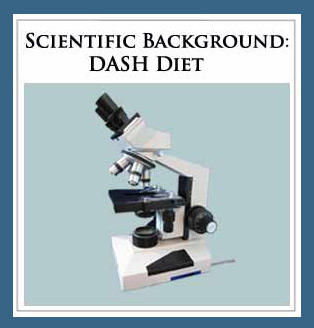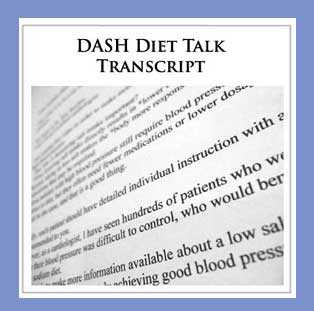
Scientific Background for DASH Dietary Recommendations made on this website (DASH- Dietary Approaches to Stop Hypertension)
The National Institute of Health (NIH) funded two landmark trials which showed the beneficial effects of the DASH dietary modifications on lowering blood pressure, both alone and in combination with a low sodium diet. 1,2. The details of this diet have been described multiple times, including on the NIH website.3 The DASH diet as initially described had a higher intake of fruits, vegetables and low fat dairy products and fewer snacks and sweets compared to the control diet.1.
Subsequently, in 2005, a number of the authors involved in the initial DASH diet trials published a study4 that improved upon the DASH diet. An approximation of the initial DASH diet was compared to two different diets that were similar to the DASH diet, but had distinct differences as well. These two modified diets both led to improved results. Blood pressures on the modified diets were lower and cholesterol profiles tended to be improved with both diets which in a sense represented modifications of the DASH diet.
The three diets that were compared were:
1. Standard DASH diet. (Though with slightly less protein: 15% vs. 18%)
2. A diet with less carbohydrate than the standard DASH diet and predominantly more monounsaturated fat with sources that included olive oil, canola oil, nuts and seeds. (Carbohydrate intake was decreased but continued to represent 48% of the diet.)
3. A diet with more protein than the standard DASH diet (2/3 of the additional protein was vegetable protein). Carbohydrate was similarly decreased but still represented 48% of the calories of this diet.
All three of these diets were tested in a setting where all the food and meal preparation was performed for the patients so the diets could be very precisely controlled.
Since both the modified diets were better than the standard DASH diet for blood pressure control and lipid levels, they appear to have some preferable features.
The DASH diet that is presented with the video and the handout incorporates into the DASH diet some of the additional dietary modifications shown in the 2005 OmniHeart trial 4 to lead to a further improvement in blood pressure.. Daily intake of nuts, seeds, and legumes averaged 0.7 servings daily in the original DASH diet1, whereas 1-2 servings is recommended in the video because the OmniHeart trial has suggested an increase in plant based protein is beneficial for blood pressure.4 Furthermore, monounsaturated oils were emphasized over other oils consistent with the benefit on blood pressure seen with monounsaturated fats in the OmniHeart trial4. In addition, a bias that whole grain carbohydrates are more healthful has been incorporated into the video, which is not required by the DASH diet at the time that this was written.
The DASH diet has been simplified on this video. When instructed by a dietician, a patient’s daily caloric needs are estimated and the amount of food is then adjusted accordingly. For example, a person that requires 1500 calories a day is instructed with the DASH diet3 to eat 4 vegetables servings, 4 fruit servings daily. A person requiring 2500 calories is advised to eat 5 vegetable and 5 fruit servings. The video simply recommends a generic 4-5 vegetable serving and 4 fruit servings in order to simplify the instruction.
In regards to the simplifications made, this was the result of my experience of instructing patients in the office. Unlike the participants in the studies who had their food prepared for them, the patient receiving information in a single session needs easily followed instructions. Though a dietician has more time for fine tuning, in my office, the more straight forward the presentation, the higher the subsequent success rate the patients reported in following the DASH diet.
Finally, details on the dietary changes that improved blood pressure and lipid levels compared to the standard DASH diet are given below to increase understanding of the three diets4 described in the JAMA 2005 article
The JAMA study4 included example meal plans to help more fully describe the diets.
The following chart uses the data presented in the JAMA study4 to show the type, as well as the details, of the diets that were tested in that study.
In regards to how these dietary modifications in the OmniHeart trial compare with the Cretan Mediterranean diet, there are features shared in common with both the protein diet and the unsaturated fat diet. There was a higher intake of monounsaturated fat in the unsaturated diet group consistent with the high plant based monounsaturated fat intake in the form of olive oil with the Cretan Mediterranean diet. However, the higher intake of complex carbohydrates and plant based protein intake present in the Cretan Mediterranean diet in this trial was part of the protein diet group.
Details of the sample diets from the OmniHeart Trial4:
| CARBOHYDRATE DIET Approximated the standard DASH dietary recommendations. Overall diet: 58% carbohydrate, 15% protein, 27% fat | PROTEIN DIET Overall diet: 48% carbohydrate, 25% protein, 27% fat (The increase in protein was 2/3 vegetable protein in origin | UNSATURATED FAT DIET 48% carbohydrate, 15% protein, 37% fat (Of the 10% fat increase: 8% monounsaturated fat and 2% polyunsaturated fat) |
|
|---|---|---|---|
| MEALS: Breakfast | Grapefruit juice Multi-bran cereal Skim milk Banana | Tomato juice Scrambled egg substitute with low-fat shredded cheese Hot cereal: bulgur wheat with soy, olive oil margarine, raisins, and sugar. Skim milk | Orange juice Cereal with raisins, skim milk White bread toast with olive oil margarine and jelly |
| Lunch | Chicken sandwich: whole wheat bread, chicken breast, mayonnaise Salad: lettuce with olive oil Trail mix: almonds, dried apricots | Vegetarian burger: hamburger roll, vegetarian patty, barbeque sauce, lettuce with tomato slices Broccoli salad Unsalted potato chips Chocolate pudding | Chicken sandwich: white bread, chicken breast, barbeque sauce, olive oil margarine Olive oil potato chips Spinach salad with tomato and olive oil balsamic dressing Broccoli salad with safflower oil Tomato juice |
| Dinner | Penne bean pasta with spinach, tomatoes, and olive oil*, beef meatballs, Parmesan cheese Tossed salad: romaine lettuce, cherry tomatoes, Italian dressing with safflower oil Fresh grapes Peppermint patty | Black bean taco: black beans and wheat protein with vegetables, 3-grain pilaf with olive oil* Tortilla chips Chicken breast Fresh orange Skim milk | Black bean taco: black beans with vegetables, 3-grain pilaf with olive oil* Tortilla chips Carrots, cooked Pecan cookie Skim milk |
| Snack | Small fresh apple Yogurt | Cottage cheese-fat free Mandarin oranges Almonds | Mandarin oranges Almonds |
* Though all the diets contained olive oil there was significantly more olive oil in the Unsaturated Fat Diet in the OmniHeart Trial.
References:
1. Appel LJ, Moore TJ, Obarzanek E, et al. A clinical trial of the effects of dietary patterns on blood pressure. N Engl J Med. 1997;336:1117-1124.
2. Sacks FM, Svetkey LP, Vollmer WM, et al. Effects on blood pressure of reduced dietary sodium and the dietary approaches to stop hypertension (DASH) diet. N Engl J Med. 2001;344:3-10.
3. The specific recommendations for the initial DASH diet are available from the NIH website: http://www.nhlbi.nih.gov/health/public/heart/hbp/dash/
4. Appel LJ, Sacks FM, Carey VJ, et al; OmniHeart Collaborative Research Group. Effects of protein, monounsaturated fat, and carbohydrate intake on blood pressure and serum lipids: results of the OmniHeart randomized trial. JAMA. 2005 Nov 16;294:2455-64.
NutritionHeart.com E. Roehm, M.D. 2018

